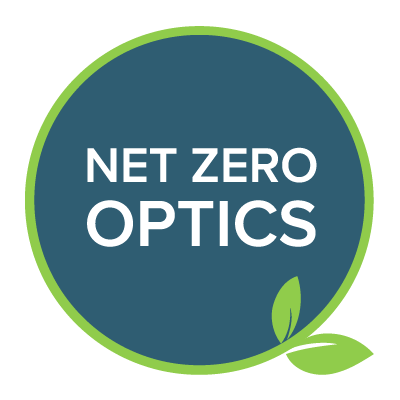CARBON REDUCTION FRAMEWORK
Use this simple checklist to take meaningful action to reduce your carbon emissions, without necessarily reducing or restricting your operations.
This framework is designed to be almost universally applicable to optical practices, suppliers and manufacturers, though some elements may be more or less applicable to any given business.
Short-term Targets. By 2030:
Scope 1 (Direct) Emissions
Reduce emissions related to heating by 100% by switching to electrical heating such as heat pumps or “green gas”.
Scope 2 (Indirect) Emissions
Reduce emissions by 100% by switching to a zero-carbon electricity supply.
Scope 3 (Value Chain) Emissions
Reduce emissions by
- Committing to zero domestic air travel for business.
- Annually exploring low-carbon options for team commuting.
- Annually engaging with MP/local authority regarding improvements to local public transport, to reduce emissions associated with team commute and patient travel.
- Continually assessing ways to reduce waste generated from our operations and supply chain.
- Requesting lower-carbon delivery options, except for items of medical necessity. (ie. Urgent jobs)
- Supporting recycling schemes that work specifically with optical-industry plastics.
- Introduce a Procurement Policy featuring clear Net Zero-aligned requirements, possibly by target years, including that all suppliers:
- have a Net Zero Commitment of no later than 2045 in place by 2026.
- have a Carbon Reduction Plan in place by 2027.
- provide product carbon footprints, [at least to the degree of proportional attribution of the company’s total carbon footprint, if not a complete product-specific life cycle assessment], by 2028. - Actively searching for the best available industry-based data for supply chain, including capital goods purchased and consumables necessary for product delivery .
- Investigate peer-to-peer activities (actions with neighbours, etc).
- Applying this framework equally throughout all franchises owned by the business.
Long-term Targets:
Scope 1 (Direct) Emissions
Reduce emissions from fleet vehicles by phasing-out fossil-fuel powered vehicles.
Scope 3 (Value Chain) Emissions
Reduce emissions by
- Reduce non-recyclable plastics across all operations to zero.
- Swapping out even "green" gas for electricity-based heating.
- Reduce air-freight in up-and-downstream distribution to zero, excepting medical necessities.
- Introduce preferential purchasing of low-carbon products and services.
FAQs
Q: Does Carbon Offsetting count as a reduction plan?
A: Absolutely not. The importance of making real, meaningful reductions to the emissions within your control cannot be understated.
However, investment in verified climate action projects (commonly known as "Carbon Offsetting" offers myriad benefits to the climate crisis and to achieving the Sustainable Development Goals, and is an important part of a Climate Action Strategy.
In short: make the reductions that you can in any given year, and once your options are exhausted then, and only then, invest in carbon "offsetting".
Learn more about our approach to Carbon Offsetting here.
Q: How do I know I'm really making an impact?
A: If you follow the Carbon Reduction Framework, you will be making a positive impact, but you may wish to quantify your real-world impacts to your Scope 1, 2 and 3 emissions, and for that you might appreciate support and third-party validation.
Our Verified Carbon Reduction Plan certification standard essentially requires that the above framework is demonstrably implemented for all scopes and (for S 1 & 2 only for SMEs) quantified.
For support towards our Verified Carbon Reduction Plan certification, we recommend Practice Building's Net Zero Optics programme..

